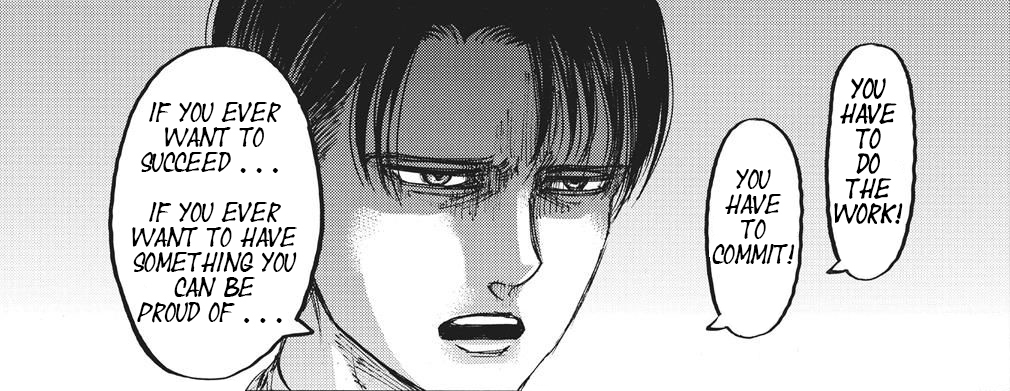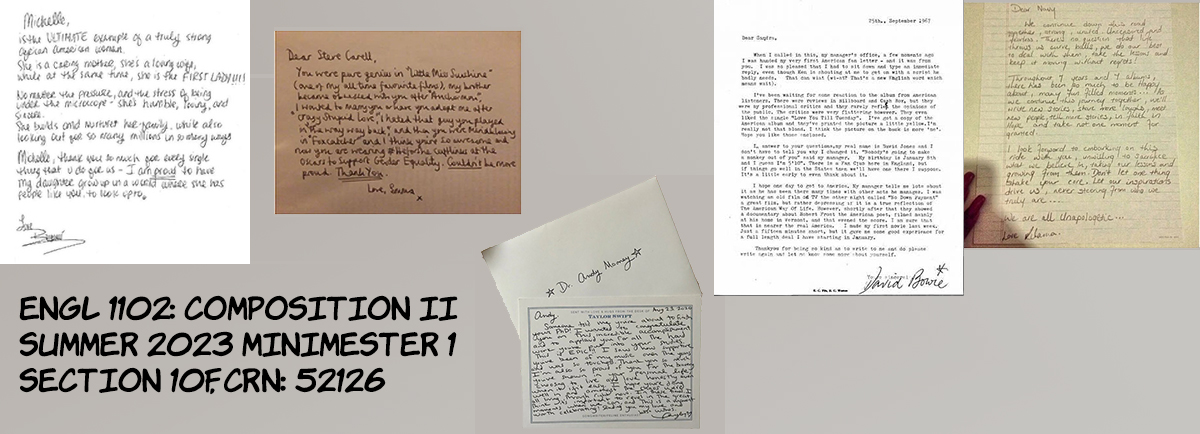

Everything you need to know for this class is in this syllabus. You might find this syllabus intimidating because of its length, but I made it a one-stop-shop for you in this course. Along with the usual material about course policies and procedures, academic integrity, and accessibility accommodations, it also contains the course schedule, explanations for all your assignments, the prompts for the papers you'll be writing, and the rubrics we'll be using.
ENGL 1102: Composition II
Summer 2023 Minimester 1
Section 10F, CRN: 52126
Online Course
Asynchronous Instruction, entirely at a distance
May 15 - Class begins - Attendance Verification due
May 15 - 17 - Drop-Add period
May 31 - Last day to withdraw without academic penalty
June 14 - Last day of classes
This course develops students' knowledge of writing beyond the proficiency required by ENGL 1101, emphasizing interpreting, evaluating, and synthesizing information to create arguments from a variety of sources using more advanced research methods. Some sections may have specific course themes.
Georgia Southern University’s First-Year Writing Program has identified specific learning outcomes for each of its first-year writing courses. Students must complete the course with a “C” average or better to earn credit. At the completion of ENGL 1102 students will be able to:
- Write Critically
- Synthesize a variety of sources to participate in a scholarly conversation
- Demonstrate purposeful and appropriate use of voice, tone, medium
- Demonstrate reasonable fluency in linguistic structures (such as syntax, punctuation, and word choice)
- Follow academic citation conventions
- Read Critically
- Use a variety of strategies for inquiry/discovery
- Find and evaluate sources in multiple genres
- Assigned Readings on Folio
- Word Processing Software or Google Docs
- PDF Reader
That means there are no costs associated with the materials for this class.
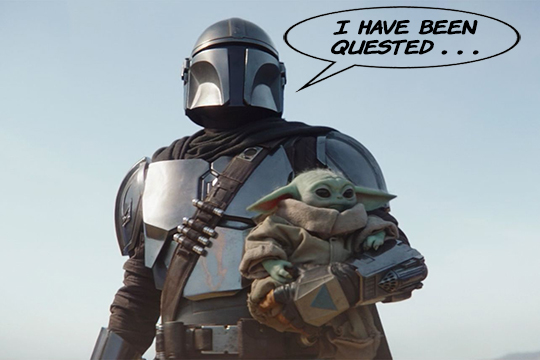
COURSE SCHEDULE
| DATE | ACTIVITY |
| WEEK 1 | |
| May 15 | Read the Syllabus / Do the Attendance Verification / Read "How to Read Like a Writer" and "What is Academic Writing?" |
| May 16 | Read "Using Sources in Your Work" / Choose a news article for your first project. |
| May 17 | Post to the Discussion Forum on "How to Read Like a Writer" and "What is Academic Writing?" / Find and read two peer-reviewed articles on the same topic as your news article. |
| May 18 | Familiarize yourself with "The English Major's MLA 9 Cheat Sheet" |
| May 19 | Summary and Analysis of News Article due |
| WEEK 2 | |
| May 22 | |
| May 23 | Summary and Analysis of Peer-reviewed articles due |
| May 24 | |
| May 25 | News Analysis Draft 1 due |
| May 26 | Peer review of News Analysis Draft 1 due |
| WEEK 3 | |
| May 29 | News Analysis Draft 2 due |
| May 30 | Peer review of Draft 2 due |
| May 31 | Final version of News Analysis Essay due |
| June 1 | |
| June 2 | Research Question for Literature Review Synthesis due |
| WEEK 4 | |
| June 5 | Bibliographic data on Articles due |
| June 6 | Article summaries due |
| June 7 | Academic Source Worksheet due |
| June 8 | Literature Review Draft 1 due |
| June 9 | Peer Review of Draft 1 due |
| WEEK 5 | |
| June 12 | Literature Review Draft 2 due |
| June 13 | Peer Review of Draft 2 due |
| June 14 | Final version of Literature Review due |
EXPECTATIONS & POLICIES
The "Carnegie Unit" is how universities define credit hours and categorize the amount of work students do for each credit hour. Each credit requires fifteen "contact hours" which are essentially the hours you spend in class during the semester. And each contact hour requires two hours of outside work, or time devoted to the class that doesn't happen in the class. This is a three-credit course, with 45 contact hours. Those 45 contact hours necessitate at least 90 hours of out-of-class work on your part. That's at least 135 hours committed for each three-credit class that you take. During a 15-week semester, this usually isn't a problem, But for this class, we have under five weeks, just 23 weekdays. And we need to cram those 135 hours of work into this space. If you do the math, that's more than 5 hours and 45 minutes of work each weekday.
If you're not a self-starter, or you have problems with deadlines, or you just don't think you can commit to this level of work, you should probably look for another section of this class.

I expect that you will conduct yourself within the guidelines of the Honor System. All academic work should be completed with the high level of honesty and integrity that this University demands.
I don't know of a person at this institution who tolerates academic dishonesty. Beyond the moral implications, as professors, we find it insulting. All instances of plagiarism will be reported to the Office of Student Conduct. Any instance will result in an F in the course and possible further sanctions. Plagiarism is presenting someone else's work as your own without giving them credit. Someone else is defined as anyone other than you: another student, a friend, a relative, a source on the Internet, articles or books. And work is defined as ideas as well as language. So taking someone else's ideas and putting them in your own words—or using someone else's words to express your ideas—is plagiarism. And, in the case of friends and family, it doesn't matter if they give you permission.
A note about group work: I encourage you to use an app like GroupMe amongst yourselves to discuss the texts we're covering, the assignments, and any other aspect of the class. If for no other reason, you need a space to complain about me, without me listening. This engagement, sharing and improving each other's work, is, in many ways, the core of our endeavor, so we hone our own ideas about the material we're covering through discussions with others. You should also discuss your writing with your classmates, as hearing a number of ideas will help you create and polish your own. However, this does not mean that you should write your papers as a group. While discussion is obviously a group activity, writing is a solitary one, and should be treated as such. Any attempt to subvert this would be an instance of academic dishonesty.
The University has a more extensive definition of Academic Dishonesty (from the Student Conduct Code):
CHEATING
- submitting material that is not yours as part of your course performance;
- using information or devices that are not allowed by the faculty;
- obtaining and/or using unauthorized materials;
- fabricating information, research, and/or results;
- violating procedures prescribed to protect the integrity of an assignment, test, or other evaluation;
- collaborating with others on assignments without the faculty's consent;
- cooperating with and/or helping another student to cheat;
- demonstrating any other forms of dishonest behavior.
PLAGIARISM
- directly quoting the words of others without using quotation marks or indented format to identify them;
- using sources of information (published or unpublished) without identifying them;
- paraphrasing materials or ideas without identifying the source;
- Self-plagiarism: re-submitting work previously submitted without explicit approval from the instructor;
- unacknowledged use of materials prepared by another person or agency engaged in the selling of term papers or other academic material.
Should you wish to pursue a case of academic dishonesty through the Office of Student Conduct, I will speak at your hearing and send a copy of this syllabus along with the documents in question to the Hearing Officer, so a plea of ignorance or non-malicious intent on your part will not be valid.
If you need additional work on the surface features of your writing, I'll let you know. Basically, if I can't understand what you're trying to say in your first paper, then you'll have to work at writing more clearly. I'll ask you to schedule sessions at the Writing Center in order to be more successful on your next paper.
The reason professors make students write papers is not because we love to mark them up, or because we somehow enjoy this. I'm willing to bet that every professor you ask would say that marking and grading papers is the worst part of their job. I know it is for me. The only thing that makes it bearable is hoping that I'll be able to engage with your ideas, or see the texts we're covering through your eyes. But if I have to stop after every sentence to figure out what you're trying to say, I'm most certainly not thinking about your ideas.
So do yourself a favor: give yourself enough time to do a good job on these papers. Remember that writing clearly takes far more time than you think it does, because you have to consider your argument from a reader's perspective, not your perspective.
I realize that the grand academic dance of submitting your work, having it evaluated, then responding to that evaluation (either through improving your work in your next paper, or by coming to see me in my office) is essentially a negotiation between us. You want to demonstrate your abilities with X amount of work, an amount that you think deserves a certain grade. You submit your work without knowing how others will see it, and only become aware of their perceptions when your work is returned to you with my comments. But this puts you at a disadvantage, because you're making your first move in this negotiation blindly.
So in the spirit of openness, let me try to level the playing field by giving you a few tips:
- This is academic writing, where clarity and concision are essential. If your work isn't clear, if every sentence doesn't hang together, you're losing the negotiation. What you have written may make sense to you, but it needs to make sense to your readers as well.
- At the post-secondary level, your work isn't evaluated in terms of the amount of work you put into it. Just like any other skill, the amount of effort necessary to master academic writing varies from person to person. I am sure that it would take me far more effort than most of you to get back to playing football. But even if I did ten times the work you did, when we both showed up on the field we'd be evaluated on our skills, not on the time it took us to gain them.
- If you pay attention to what the prompt is asking you to write about, and keep that in mind as you think about your paper, you're making a good start.
- If you look at the rubric, especially the distinctions between the levels of performance in content and form, you should get a good idea of how successful your paper will be.
- If you're wondering if your "X amount of work" is enough, it isn't.
- And one last personal comment:
Before we had things like TurnItIn and other automatic checkers on academic integrity, I was the guy other faculty members went to to track down cases of suspected plagiarism. When Google was just getting off the ground, I was a beta tester for them (one of 25 in the country). I've also been teaching English for over 40 years now. So if you're thinking that you've changed enough of that material that you've copied and pasted to make it look like your own work, think again. If writing and evaluating papers is a negotiation, then presenting someone else's work as your own is a gamble, and you're betting your academic career that you can get away with it. I've just told you what I bring to the table, so if you really think you can get away with it, my only advice is to do it as early as possible, so you can spare yourself the work for the rest of semester, because you'll already be gone from this class.
I'm sure you're aware of the effectiveness of current plagiarism checkers like TurnItIn. When you submit a paper in this class, Folio automatically sends that paper to TurnItIn for an originality check. TurnItIn compares your work to the material in its database, which currently contains over 54 million student papers. It marks the parts of your text that are similar to the material in that database, and then produces a report that both you and I can view. The most recent study on its effectiveness claims that it has reduced plagiarism in papers submitted to institutions of higher education by at least 39%. It's not perfect, but it's an invisible tool that tells me how original your work is before I even consider marking it.
You may have heard of ChatGPT and GPT-3.5, a new technology developed by OpenAI research laboratory, which uses artificial intelligence (AI) to enable natural-language conversations. And you may have heard that it can produce college-level essays that are both well-constructed and original. But have you seen GLTR, the Giant Language model Testing Room? It's a tool developed by researchers from the MIT-IBM Watson AI lab and the Harvard Natural-Language Processing Group. Basically, it's TurnItIn on steroids, but for AI-generated text. It is currently 98.65% accurate in identifying text written by AI, and literally getting more accurate every day.
I'll be using GLTR to check your papers. If it returns a positive score for the work you submitted, I'll treat it as I would any other instance of academic dishonesty.
ASSIGNMENTS
You'll have two major projects for this class. Both of them will be scaffolded. That's where a large assignment is broken into smaller parts, and at the end you put those smaller parts together to create a completed whole. You'll also write multiple drafts for each of these projects, and submit them to your classmates for peer review. This is to ensure that what you submit as your final version for each of these is as good as you can make it.
Those peer reviews will also count toward your final course grade, as will a required post in a discussion forum and multiple optional forum responses.
Once you've read the first two articles in the schedule, you'll address several questions about them in a multi-paragraph post to a discussion forum. The questions address your level of engagement with those texts, while your responses will tell me how much attention you pay to your own writing, and how easily you can move from offering an opinion to creating an argument. This is a low-stakes assignment, worth only 5% of your final grade, but don't take it lightly. It lays the groundwork for you for the remainder of the class.
For this assignment, you'll select an online news article of your choice on a topic related to your major field of study. You'll then do some background research on the content of the article using credible supporting sources, such as peer-reviewed research or primary documents such as laws, government studies or reports, police reports, medical reports, or reports from reputable professional or non-profit organizations.
Then you'll use at least two of these credible supporting sources to confirm, refute, or complicate the claims of your news article. You'll cross-reference the claims in your popular article with the information you find in the credible supporting sources, and determine whether the supporting sources confirm the claims in the popular article, or reveal any inaccuracies or misrepresentations the authors may have included.
- You'll summarize each source accurately and effectively, and explain and justify each individual source’s credibility, accuracy, and purpose.
- You'll make an argument that evaluates the accuracy, fairness, and overall quality of your popular news article, and explain whether or not you would recommend the article as a good source of information for your readers.
- You'll explain how the supporting texts confirm, refute, or complicate the claims and characterization in the popular news article, and cross-reference key claims with evidence from the supporting sources.
- You'll practice academic writing genre conventions, such as clear organization, correct citation, and other technical elements.
See the Course Schedule for the due dates for each piece of this assignment.
- Choose a news article on any topic pertaining to your field of study.
- Read it, taking notes as you do so.
- Write a brief summary and analysis of it (1 paragraph summary; 1 paragraph analysis).
- Submit the URL of your article along with your summary & analysis.*
- Find two peer-reviewed research articles or primary documents addressing the same topic as your news article.
- Read those articles, taking notes as you do so.
- Write more extensive summaries and analyses of these two articles (8 paragraphs total: 2 paragraphs summarizing article #1, 2 paragraphs of analysis of article #1; 2 paragraphs summarizing article #2, 2 paragraphs of analysis of article #2).*
- Place all three sources in conversation with one another. Use the credible supporting sources to confirm, refute, or complicate the claims of your popular news article. Cross-reference claims from your popular article with information you find in the credible supporting sources, and determine whether the supporting sources confirm the claims in the popular article, or reveal any inaccuracies or misrepresentations the author(s) of your initial article may have included.
- Write and submit the first draft of your News Analysis Essay.*
- Participate in Peer Review of other first drafts.*
- Using any comments you find useful from the Peer Review of your first draft, edit it and submit it as your second draft.*
- Participate in Peer Review of other second drafts.*
- Using any comments you find useful from the Peer Review of your second draft, edit it and submit it as your final draft.*
For this assignment, you'll write a literature review of at least three current academic publications from your major field of study. You'll summarize the key elements of each source, such as the research methods used, the evidence presented, and the results or conclusions the author(s) reached. You'll then compare the methods and findings of each of your sources to at least one other source, and synthesize conclusions about your chosen topic based on the body of your research. You'll wrap it all up by explaining the current state of expert knowledge in your field on this topic, and recommend avenues for future research to fill in any information gaps amongst your colleagues in the field.
- You'll find, select, and summarize at least three appropriate academic sources, which should be current, peer-reviewed research on a narrow area of study.
- You'll accurately discuss each source’s aims, methods, evidence, and conclusions.
- You'll compare each of your sources to at least one other of your sources, and note similarities or differences in the researchers’ aims, methods, or conclusions.
- You'll synthesize the body of your research by explaining trends or conflicts among your sources, addressing the current state of knowledge on your topic among experts in the field.
- You'll recommend future avenues of research to fill in knowledge gaps or explore new applications of the topic.
- You'll practice academic writing genre conventions, such as organization, citation, and other technical elements
See the Course Schedule for the due dates for each piece of this assignment.
- Generate a research question pertaining to your major/intended field of employment.
- Find three peer-reviewed scholarly articles on your research question.
- Read the articles, taking notes as you do so. Write down the bibliographic date for them.
- Submit your research question and bibliographic data for the articles.*
- Write and submit a 2-paragraph summary for each article (6 paragraphs total).*
- Read the sample Academic Source Worksheet.
- Complete and submit an Academic Source Worksheet for your articles.*
- Write and submit the first draft of your Literature Review.*
Use the following structure for this Review:
Opening: Provide the bliographic data for the three sources, in MLA 9 format.
Section 1: Summarize your sources.
Section 2: Compare the methods and findings of each of your sources to at least one other source, and synthesize conclusions about your chosen topic/research question based on what your sources have to say about it. Ask how they address your question. Offer a conclusion based on what they say. Use them to support your conclusion, not make it for you.
Section 3: In a short discussion section, explain the current state of expert knowledge in your field on this topic.
Section 4: Recommend avenues or possibilities for future research to fill in any information gaps amongst your colleagues in the field. - Participate in Peer Review of other first drafts.*
- Using any comments you find useful from the Peer Review of your first draft, edit it and submit it as your second draft.*
- Participate in Peer Review of other second drafts.*
- Using any comments you find useful from the Peer Review of your second draft, edit it and submit it as your final draft.*
For most writers, it's difficult to see where we made mistakes in our writing. But it's much easier to see those very same mistakes in someone else's writing. That's because when we proofread our own work, we don't really read what we wrote. We read what we thought we wrote. But when we pass that ame piece of writing to someone else, they have plenty of questions, because they have no idea about what we meant to write; they only see what we actually wrote. For each of your major projects in this class we'll have two peer review sessions. You'll post your first and second drafts of your completed project to the appropriate discussion forum, where another student will read it and then complete a review worksheet on it. You'll see the worksheet with their comments. You'll then be able to heed or ignore their advice and make changes to your work.
So for each project you'll be looking at the work of two other students (draft 1 and draft 2), and two other students will be looking at your drafts. There are some caveats about this, like you can't review the work of the same person more than once, and you don't get to choose who reviews your work; it's all about the luck of the draw.
As a reviewer, your evaluation for this process is based on the accuracy and thoroughness of the advice you give your fellow students. Since you'll have access to an MLA 9 Formatting Cheat Sheet, merely pointing them to the Cheat Sheet is low-hanging fruit. But the worksheet you'll be completing will require you to address the organization and development of the paper, its focus and content, its clarity, mechanics, and then documentation.
As a writer, you're free to accept or reject the suggestions made by your peers. In general, if someone doesn't understand the big structures in your work, or they say that you're not clear enough in your writing, you shoudl listen to them. But if you're quibbling over whether to use which or that in a sentence, those issues are more easily ignored. Of course, if someone is questioning your sentence structure, or they say they can't make heads or tails of what you're trying to say because you're missing words or not explaining yourself clearly enough, then you should check your work carefully.
In short, as a writer you're responsible for your own work. If you submit something that I end up marking as incorrect, you can't say, "well, my peer reviewer told me to put it that way." In the end, you're the one who has to make the decisions about your own work. Your only solace may be that your reviewer scored poorly on that area of the project, because they gave you bum advice.
There's only been one sure-fire way that has been proven to help you get better as a writer, and that's to write, then revise, then write some more then revise some more, and so on. And since this is a writing class, I'll give you more opportunities to write, and even incentivize those opportunities. So throughout the class I'll be posting at least five and perhaps up to ten Bonus Discussion Questions in the Discussion Forums. Responding to one will get you one point added to your final grade for the class. But in order to get that free point, there are some guidelines:
Purpose: You should address the central question in the forum.
Length: The total length of your response should be between 350 and 500 words, in multiple paragraphs (which means you need to make multiple points in your response).
Argument: Many of these questions will ask you to turn your opinion into an argument, by providing some kind of evidence beyond your personal experience.
Clarity: I should be able to understand what you're trying to say without having to guess at what you mean.
Mechanics: Your response should look like a polished piece of writing, not like some first draft you just dashed off. The more errors in grammar and usage it contains, the more obvious it is that you really didn't work on it.
What's on the table here is the chance to add between five and ten points to your final grade in the class. That's a minimum of one-half of a letter grade, and a maximum of a full letter grade. When you combine this with the potential to revise your first project for a higher grade (see below), your grade in this class is determined significantly by how much work you're willing to put in to improve your writing.
WRITING EVALUATION
When I mark your papers, here's my process: I read your papers at least three times. The first time, I just go through them looking for your argument and if you addressed the prompt in your essay. Next I'll read through your paper again, asking the questions I have here. Then I'll go through it with the Essay Rubric below. This reading is where I mark your paper.
For each sentence in your paper, I ask the following questions:
- What are you saying? At a basic level, I’m trying to decode the meaning of each sentence. If I cannot understand what you’re trying to say, everything that follows is problematic. If your sentence is confused, convoluted, or contradictory, you make it difficult, or even impossible, for me to answer this basic question.
- Is what you’re saying accurate? Does this sentence demonstrate that you understand the text or the critic you’re addressing? For instance, if you’re summarizing someone else’s argument, I need to assess if you’re being true to the original author's intent. In your response, I’m assessing your evidence and examples.
- Is what you’re saying well-expressed grammatically and mechanically? This assumes that your grammar and mechanics aren’t so bad that I’ve been stymied back up at Question #1.
- Does the writing have appropriate flow, in that each idea links up with the one previously and the one to follow in a way that meets audience needs, attitudes, and knowledge?
If I can answer all four of these questions positively for every sentence, you’re doing well. But when the answer is no, complications ensue. If I can’t understand what you’re saying, I have no way to engage with your ideas, and so I have additional questions.
- Do you not understand the original text you’re addressing?
- Do you understand the original text, but your writing leaves a gap between that understanding and what is written on the page?
When I return your first project to you, it will have marks on it, but almost no comments. Only in very rare cases, where issues aren’t immediately obvious, will I write a short comment. For the most part, your errors or issues are underlined and marked with a letter representing one of four categories:
| MARK | EXPLANATION |
|---|---|
| A = ARGUMENT | These are errors or issues with the points you’re trying to make. They could be inconsistencies in your argument, the use of quotations that don’t do what you need them to do, fundamental contradictions in your structure, or a number of other things concerning how you’re moving your argument forward. |
| C = CLARITY | These are usually sentence-level matters where you either need to be more clear and specific, explain yourself better, or resolve a contradiction. |
| F = FORMAT | You should use MLA 9 formatting for your paper. You'll follow it to set up how your paper looks on the page (your header, your margins, your page numbering) and how you handle things like titles of works, using quotations in your text, and creating a Works Cited page. You have The English Major’s MLA 9 Formatting Cheat Sheet available to you in Folio. “I used an online citation generator” is one of the most damning criticisms of your own abilities you can offer. If I suggested you weren’t capable of looking up and following a simple set of rules, you would be offended. So why would you admit that about yourself, especially since I'm telling you here that they are all, to varying degrees, inaccurate? |
| M = MECHANICS | Errors in sentence construction, usage, punctuation, spelling, etc. In general, there’s a reason why English has at least 64 different prepositions: they all mean something different. Oh, and burn your thesauruses. Using an elevated word that you think you might know the meaning of works doubly against you: it could be the wrong word for the situation, and it’s not the clear and concise word, which is what you want. Brackets [. . .] usually indicate errors with sentence construction. |
I know, I know. You put in a ton of work on this project, and you still didn't get the grade you think you deserve. So what can you do? Here's a plan: first, remember that you're not graded on your effort; you lost that after kindergarten. But I've built in a chance for you to revise your final version of your first project for a higher score. No matter the grade marked on your original submission, you can revise it for an additional 10 points (that's a full letter grade). I would normally have this available for your second project as well, but since it's due on the last day of class, that won''t be possible.
So if you'd like to do revise your first project after you've seen my marks on it, you'll have one week after I return your papers to do the following:
- In a separate document, explain what the error is for each underlined area of your paper. (The A, C, F, or M will be your initial guide to figuring this out.)
- Revise your paper, correcting EVERY error.
- Submit a) your original document (the one that is marked), b) the document you produced explaining the errors, and c) your revision, to the same dropbox where you submitted your initial attempt.
| 1102 PROJECT RUBRIC | ||
| GRADE | CONTENT | FORM |
| A |
|
|
| B |
|
|
| C |
|
|
| D |
|
|
| F |
|
|
COURSE EVALUATION
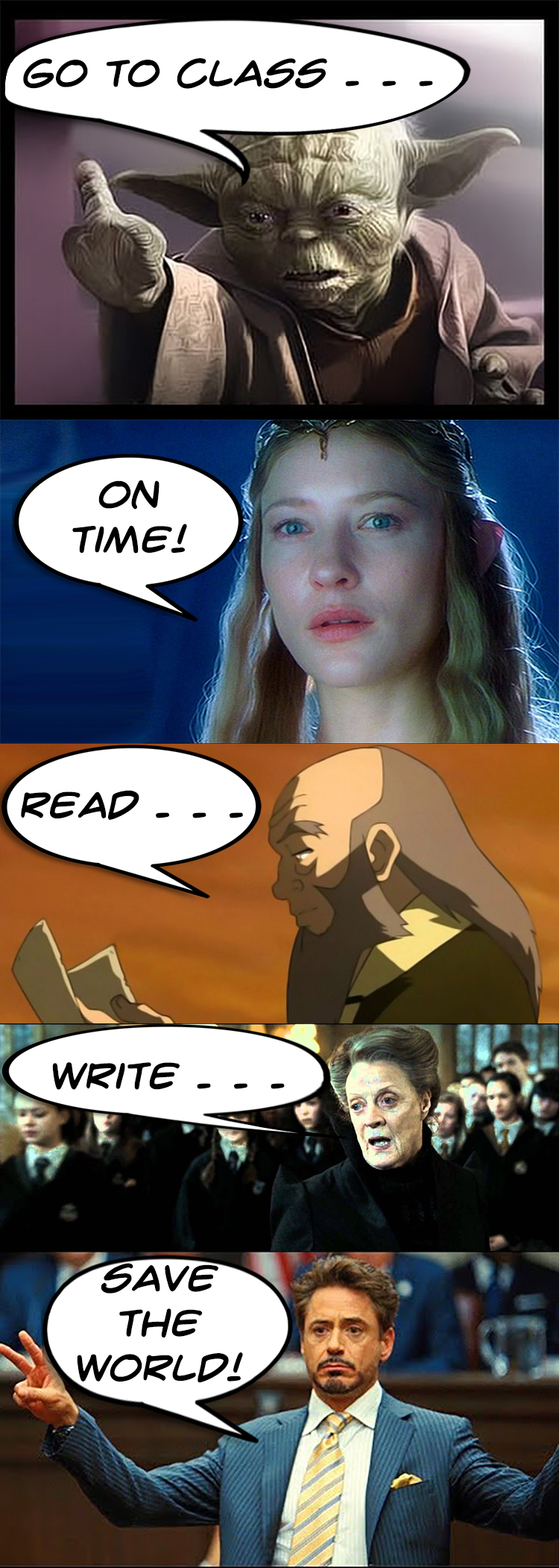
A = 100-90
B = 89-80
C = 79-70
D = 69-60
F = 60-0
W = Withdrawal from course
WF = Withdrawal/fail
WORK |
WEIGHT |
||
| Discussion Forum Post | 5% |
||
| Project #1: News Analysis Essay | 40% |
||
| Summary and Analysis of News Article | 10% | ||
| Summary and Analysis of Peer-Reviewed Research Articles | 15% | ||
| First Draft of News Analysis Essay | 15% | ||
| Participation in Peer Review of Draft 1 | 5% | ||
| Second Draft of News Analysis Essay | 20% | ||
| Participation in Peer Review of Draft 2 | 5% | ||
| Final Version of News Analysis Essay | 30% | ||
| Project #2: Literature Review | 55% |
||
| Research Question/Bibliographic Data | 5% | ||
| Article Summaries | 10% | ||
| Academic Source Worksheet | 10% | ||
| First Draft of Literature Review | 15% | ||
| Participation in Peer Review of Draft 1 | 5% | ||
| Second Draft of Literature Review | 20% | ||
| Participation in Peer Review of Draft 2 | 5% | ||
| Final Version of Literature Review | 30% | ||
| Bonus Discussion Questions | +5 - +10 | ||
| +1 for each sufficient answer | |||
INSTRUCTOR

I'm Dr. Joe Pellegrino, an Associate Professor in the Department of English. I teach lots of different classes; I'm kind of the like the utility infielder of the English department. My specialties are Irish literature and postcolonial literature, so I end up doing classes that don't fit into the standard Brit Lit/American Lit model: Irish lit, African lit, etc. For instance, next semester I'll be teaching a huge course on graphic novels for students in any major, and the semester after that I'll be teaching a seminar just for English graduate students that's limited to 12 students.
It seems like I went to school forever, and went to lots of different schools: Duquesne University, St, Louis University, Mannes College of Music, The New England Conservatory, and UNC-Chapel Hill, which is where I got my PhD. I've also taught at a lot of schools: Duquesne, UNC, Eastern Kentucky University, University of South Carolina-Upstate, Greenville Tech, Converse College, and here at Georgia Southern. I've got some experience in online education; I was a University Director for the (short-lived) Kentucky Commonwealth Virtual University, and have taught online classes for over 20 years now.
Professionally, I also edit an international journal, The International Journal for the Scholarship of Teaching and Learning. I'm interested in a number of fields, but most of my publications are either on Irish studies, postcolonial lit, or teaching.
I have only one item on my bucket list: to see the Northern Lights. One day I'll get there, but in the meantime I'm raising two daughters, making heirloom furniture (pretty much a middle-aged guy cliché), keeping up with new technology, wishing I could spend more time doing music, and trying to keep my head above water.
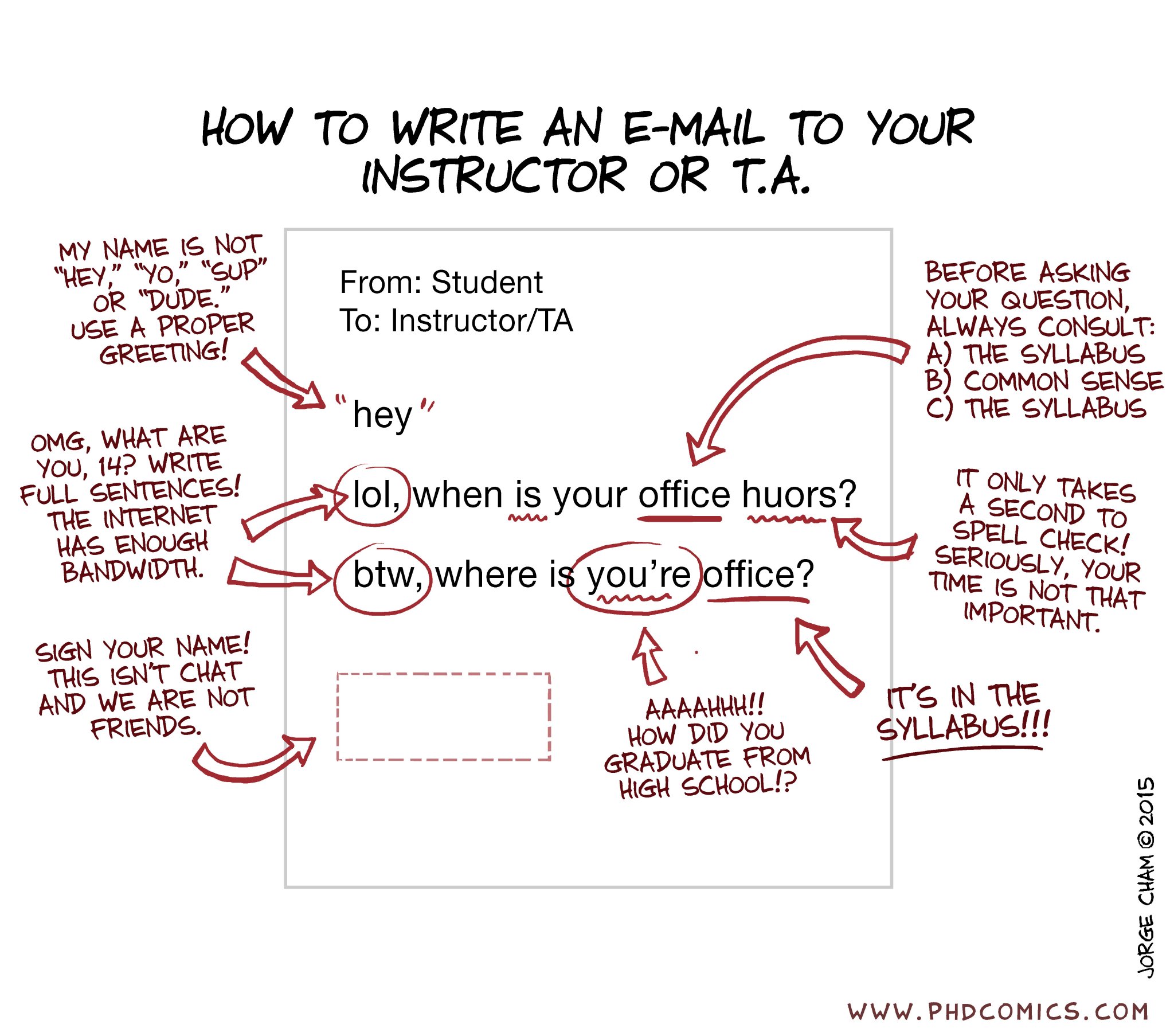
Office: 3308B Newton Building, Statesboro Campus
Email: jpellegrino@georgiasouthern.edu
Phone: 912.478.5853
Please don't hesitate to post to me if you have a question about any of the readings, especially if you're struggling to figure them out. But please think twice about posting questions where the answer is in this syllabus. If you do, I have two options for a reply: I can copy and paste material from the syllabus or schedule just for you, but that's redundant, since you already have access to the material. Or I can reply with something like "check the syllabus" or "check the schedule," which you should already know to do. Since neither of those are satisfactory, if you ask a question that is already answered in the syllabus or in the schedule, I won't be replying at all. So if you don't hear back from me, you should know that the answer to your question is in this document.
RESOURCES
In compliance with the Americans with Disabilities Act (ADA), this course will honor requests for reasonable accommodations made by individuals with disabilities or demonstrating appropriate need for learning environment adjustments. Students must self-disclose their disability to the Student Accessibility Resource Center (SARC) before academic accommodations can be implemented. Students requesting alternative educational arrangements must submit a completed COVID-19 Alternative Educational Arrangement Request Form to the SARC office. For additional information, please call the SARC office at (912) 478-1566 on the Statesboro campus, or at (912) 344-2572 on the Armstrong and Liberty campuses.
The Writing Center at Georgia Southern University gives students the opportunity for individualized feedback on their writing from experienced writers and teachers of writing. If you're near the Statesboro or Armstrong campuses and would like some help with your work, here are the hours that they're open:
|
Armstrong Campus: Lane Library, First Floor, back right corner Phone: 912-344-3072 Summer 2023 hours: M-Th 11 am – 4 pm |
Statesboro Campus Henderson Library, Rooms 3302 D&E. Phone: 912-478-1413 Summer 2023 hours: M-Th 12 pm – 5 pm |
If you don't believe me, take it from Levi Ackerman:
